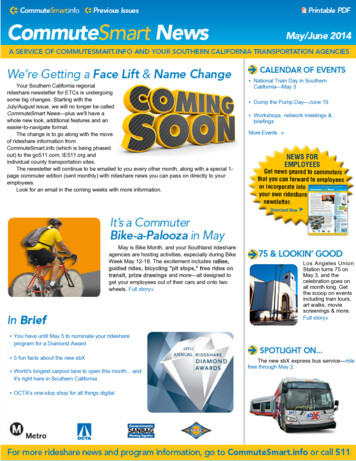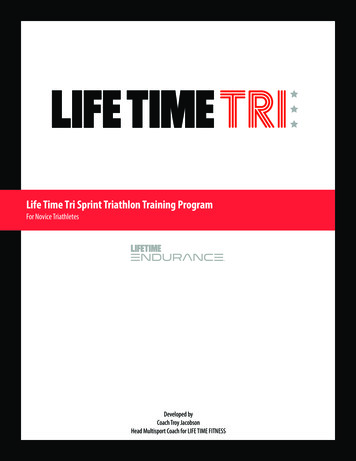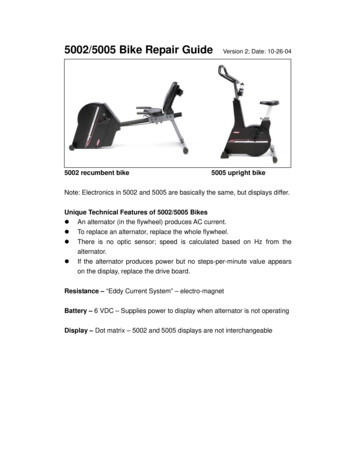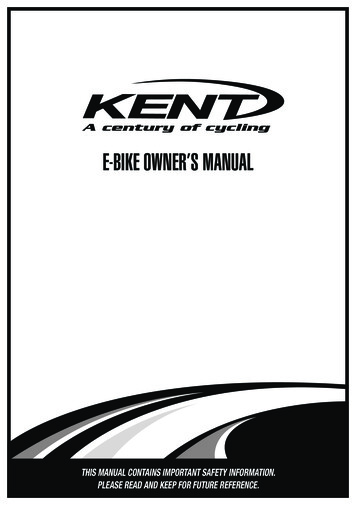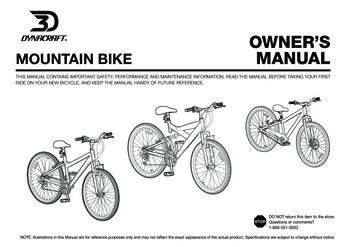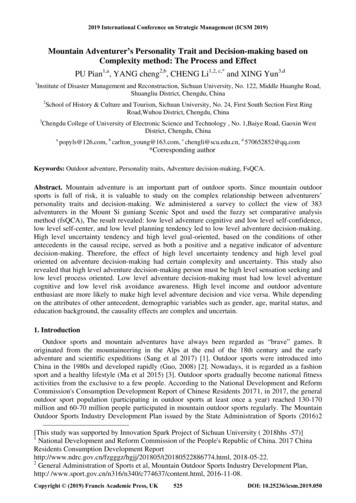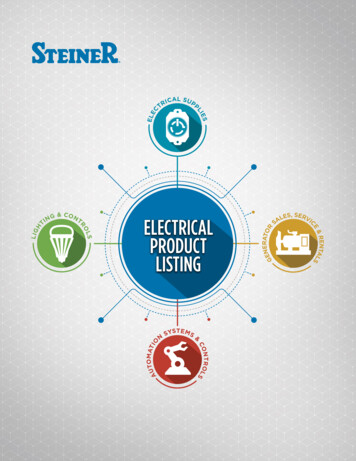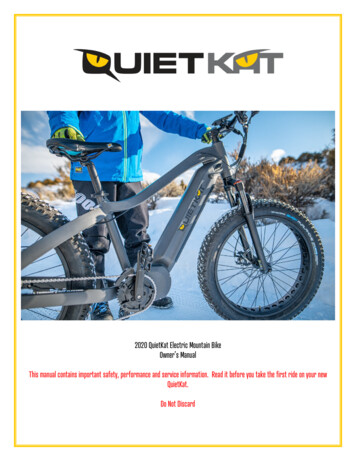
Transcription
2020 QuietKat Electric Mountain BikeOwner’s ManualThis manual contains important safety, performance and service information. Read it before you take the first ride on your newQuietKat.Do Not Discard
2020 Product ManualTABLE OF CONTENTSINTRODUCTIONJake Roach, CEO Of QuietKat3FOREWORD ON SAFETY4THE QUIETKAT BIKES5CHAPTER 1 – Unboxing And Assembly14CHAPTER 2 – How To Charge And Power On20CHAPTER 3 – Battery Care22CHAPTER 4 – Safe Operation, Maintenance And Inspection23CHAPTER 5 – Warnings24CHAPTER 6 – Warranty Information25CHAPTER 7 – Shipping Damage Claims26CHAPTER 8 – Return Policy26CHAPTER 9 – Error Codes27CHAPTER 10 – Frequently Asked Questions282
2020 Product ManualIntroductionThank you for purchasing an electric mountain bike by QuietKat.This is a serious piece of machinery designed for use by adults in fully controlled and safe environments. As the purchaser/owner of the bike, you areresponsible with the task of keeping the rider safe at all times. Your bike has great capabilities and can grow with the skills of the rider to high levels, but itis imperative that the responsible adult is in control during the entire learning process and gives full attention at all times.The QuietKat is designed for off-road use, but can also be ridden on the road. Please obey all laws regarding Electric Assisted Bicycles and/or MotorizedVehicles and their usage in your area. QuietKat may only be ridden in safe areas where all laws are being followed and all required permissions are given.QuietKat recommends the use of a DOT (Department of Transportation) rated helmet at all times.Because it is impossible to anticipate every situation or condition which can occur while riding, this manual makes no representation about the safe use ofthe bicycle under all conditions. There are risks associated with the use of a bicycle which cannot be predicted or avoided, and which are the soleresponsibility of the rider.This Owner’s Manual provides important information regarding safety and maintenance of your QuietKat e-bike. Please read through the entire manual priorto operating your machine and save this manual for future reference. Visit www.QuietKat.com for updated information.If at any time you have questions or need assistance with the maintenance of your QuietKat product, please contact us using the contact information belowand throughout the Owner’s Manual.Thanks again for purchasing a Quietkat product. We hope you enjoy the ride!Jake Roach, President – QuietKatQuietKat Contact Information:Service & Support - customerservice@quietkat.comAccounting - accounting@quietkat.comGeneral Info - info@quietkat.comSales - sales@quietkat.com(970) 328-23993
2020 Product ManualForeword on SafetyAn electric bicycle can be a great way to access terrain that may be impossible by any other means. It can also be dangerous, especially if you ride terrainabove your ability level or beyond the capability of the bike itself. If you are headed into the backcountry, be prepared. QuietKat recommends bringing a bikespecific multi-tool that includes various Allen Keys, Screwdrivers, and a Bicycle Chain Tool. Bring water, food and clothing appropriate for the season and theenvironment. A dry trail with good traction may turn impassible with a little rain, meaning you will need to walk the bike. Always practice proper backcountrysafety protocols.The bicycle will not protect you in an accident. There are no seat belts or air bags, and therefore a crash even at low speeds can result in injury or death. Ifyou are in an accident, inspect the bike thoroughly before continuing with your ride. If you aren’t sure, do not ride the bike; take it to a professional bicyclemechanic or repair shop for a professional inspection.If you experience any mechanical problems while on a ride, immediately turn off the electric power at the battery prior to attempting any repairs. Repairsinclude anything such as putting the chain back on, adjusting brakes, or adjusting accessories. Attempting to replace or re-engage the chain while the poweris on could result in injury.Secure all cargo, and ensure loose straps are secured to avoid interference with the moving parts on the bike. Be aware of loose clothing, especially on thedrive side (Right Side) of the bicycle, as to avoid interference between your clothes and the drivetrain. Be sure the wheels spin freely and there is nothingthat could get caught in the spokes or prevent the wheels from turning freely. If you get a piece of clothing or equipment caught in the front chainring, firstturn the power off. The chainring is not on a freewheel system and won’t go backwards like a typical bike. You may need to be prepared to cut or removeclothing that gets caught in the drivetrain in order to remove it from the system.QuietKat electric bicycles use lithium-ion battery technology which require some care and maintenance. Please refer to the Battery Care section of thismanual for important safety and care information for the battery.The QuietKat bike is a fun and exciting ride! Always be aware of your surroundings and your environment. Be cautious of other riders and pedestrians. Alwaysstay in control and within your ability. QuietKat always recommends the use of a DOT (Department of Transportation) Rated helmet at all times.4
2020 Product Manualjeep e-bike5
2020 Product ManualRidgeRunner6
2020 Product ManualQuantum7
2020 Product ManualAPEX8
2020 Product ManualWarrior9
2020 Product ManualRanger10
2020 Product ManualRipper11
2020 Product ManualVillager12
2020 Product ManualVoyager13
2020 Product ManualChapter 1 – Unboxing and AssemblyQuietKat recommends that the bike be assembled, inspected and adjusted by a certified bicycle mechanic or bicycle shop before riding. For more informationon assembly, check out our assembly and maintenance videos at www.QuietKat.com.You Will Need:4mm Hex KeyCable Cutters5mm Hex KeyGeneral Purpose Grease15mm Wrench or Pedal WrenchTorque Wrench (Optional)Phillips Head or JIS ScrewdriverUnboxing1- Carefully remove the bike from the box.a. Use caution when opening the box as there may be staples exposed when opening thelid.b. It is easier to clip the zip ties attaching the front wheel to the bike and remove thefront wheel from the box first.c. Take out all the accessories and the box with pedals and other miscellaneous parts, andthe Battery Charger before removing the bike.2- Remove all bubble wrap and other packaging materials and place them back in the box.3- Be careful not to cut hydraulic brake lines when removing zip-ties and protective packaging.4- Install the seat-post into the seat-tube and hang the bike from a bike repair stand (if possible).a. If you do not have a repair stand, place the bike on the floor and engage the kickstand.Use caution as the bike could tip over prior to installing the front wheel, even with thekickstand engaged. For extra safety, lean the bike against a wall or solid object to avoidtipping over.5- Attach the handlebars.a. Using a 4mm allen wrench, remove the 4 screws from the front of the stem and removethe bracket.b. Place the handlebars on the stem, with REAR brake and gear shifter (if equipped) on theriders RIGHT and put the bracket and 4 screws back into place.i. Don’t worry about aligning the handlebars yet. Tighten the screws until snug.DO NOT OVERTIGHTEN!14
2020 Product ManualAttach the Front WheelQUANTUM1- Remove the quick-release axle from the fork. To remove, align the quick release lever with the groove inthe axle body. Turn anti-clockwise to loosen the axle from the brake side fork leg. Once the threads areremoved from the brake-side fork leg, pull the axle out through the drive side.2- Align the front wheel’s hub with the fork legs, and be careful to align the brake rotor into the calipera. If the brake lever was squeezed, or the pistons have squeezed the brake pads together, use aBrake Pad Spreader to push the pistons back to their open position (Hydraulic Brakes Only). Ifyou don’t have a spreader, you can carefully use a clean, flat head screwdriver.3- Insert the axle running through the fork legs and the hub of the front wheel. When the axle reaches thebrake-side fork leg, turn the axle clockwise to thread into the fork leg.4- The axle should be snug, then the quick-release lever can be turned into position (pointing up andtowards the rear of the bike) and secured to fully tighten the axle to the hub.5- DO NOT USE A TOOL to add leverage to close the quick-release lever.6- Rotate the wheel in the fork to ensure clearance of the brake rotor in the caliper7- Fine tune the brake caliper if needed. (SEE PG 17)15
2020 Product ManualAttach the Front WheelRIDGERUNNER / APEXThe 2020 RidgeRunner and Apex bikes use an inverted fork which provides maximum stiffness andtraction. Inserting the front wheel on this type of design can be tricky, so follow these instructionscarefully.1.2.3.4.5.6.7.8.Remove the axle from the fork.a. First loosen the clamps on the bottom of each fork leg with a 5mm hexwrench.b. Ensure both bolts on each leg are loose, in some cases you may need to removethe bolts completely for this step.c. On each end of the axle is a 4mm hex-head bolt. Remove the brake side bolt.d. Reach between the fork legs and guide the axle out towards the drive-side forkleg.i. You can use a tool on the 4mm hex-head bolt on the drive side totwist the axle to help break the friction.Align the wheel between the fork legs and be careful to align the brake rotor into thecaliper.a. Because of the inverted design the fork leg may twist, this is normal. Simplytwist the fork leg into position to align the brake rotor and caliper.b. If the brake lever was squeezed, or the pistons have squeezed the brake padstogether, use a Brake Pad Spreader to push the pistons back to their openposition (Hydraulic Brakes Only). If you don’t have a spreader, you can carefullyuse a clean, flat head screwdriver.Insert the axle through the drive-side fork leg, through the hub, and through the brakeside fork leg.Insert the 4mm hex-head bolt into the axle on the brake side. Tighten to 7nm.Ensure the drive side 4mm hex-head bolt in the axle is tight to 7nm.Tighten the clamps on the bottom of each fork leg with the 5mm bolts.a. Tighten the clamps to 10nmRotate the wheel to ensure proper brake clearance on the rotor.Re-align the brake caliper on the rotor if needed (SEE PG 17)16
2020 Product ManualWARRIOR, RANGER, RIPPER, VILLAGER, VOYAGER1- Place the axle into the dropouts on the front fork, be careful to align the brake rotor into thebrake caliper.a. If the brake lever was squeezed, or the pistons have squeezed the brake padstogether, use a Brake Pad Spreader to push the pistons back to their openposition (Hydraulic Brakes Only). If you don’t have a spreader, you can carefullyuse a clean, flat head screwdriver.b. Make sure the washer is between the fork and the 15mm nut.Center the wheel in the fork. The tire should have equal space on each side.c. If the wheel is not centered, loosen the 15mm nuts on the axle, and straighten. Itcan help to put the bike on the floor (if on a stand) and let gravity help lower thedropouts around the axle.2- Use your 15mm wrench to tighten axle nut until snug. DO NOT OVERTIGHTEN! The nut should behand tight, do not use a power tool as you can damage the axle threads.a. Be careful when tightening to ensure the axle stays parallel to the ground. Placesome weight over the handlebars and press down while tightening the nuts toensure the axle stays level and straight.3- Re-align the brake caliper on the rotor if needed (SEE PG 17)17
2020 Product ManualAlign the Brake Caliper and Rotor1.2.3.4.5.6.With the wheel inserted into the bike, loosen bolts that attach the brake caliper to the adapter just enough sothe caliper can move side to side.Squeeze the brake lever to engage the pistons and squeeze the rotor with the pads; keep it squeezed whiletightening the Brake Caliper bolts.Release the brake lever and spin the wheel to ensure the rotor is centered within the pads.For Mechanical Disc Brakes, you can make fine adjustments to the inside pad position with a 5mm Allen key onthe side of the brake caliper.The same process can be used for both front and rear brakes.For more information on disc brakes and disc brake care and maintenance, go to QuietKat.com for a fullcatalog of maintenance videos.ATTACH THE PEDALS1- The pedals are left and right side specific. The end near the threads will have an L or R on them,indicating Left and Right.2- Put a small dab of grease on the threads of each pedal before inserting into the crank.3- The right side is threaded normally, and the left is reverse threaded. This must be screwed in opposite tothe right (to the left).The greased pedal should thread on smoothly, DO NOT CROSSTHREAD!4- Pump tires to desired pressurea. The range for the tires is from 5psi to 30psi.b. 5psi is the lowest the tire is rated for.c. 5-15psi is for very soft sand or snow.d. 15-25psi is the recommended range for most off-road riding, depending on your preferencesand the specific terrain you are travelling.e. 25-30psi is for pavement or hard, smooth surfaces.f. Lower pressures can provide more traction, however increase the risk of punctures, anddecrease the range of the motor. Higher pressures can decrease the possibility of a puncture,but also can decrease grip on softer and varied terrain.g. We recommend using a 2psi difference between the Front tire and Rear Tire ( 2psi in the Reartire) to maximize traction in the front and stability in the rear. Example: 15psi Front, 17psiRear)h. If you are in an area with a lot of thorns we recommend adding a tube/tire sealant or liner.18
2020 Product ManualAlign the Handlebars and Brake Levers1- If you have the bike in a repair stand, place the bike on the floor.2- Align the handlebars to the correct angle.a. Loosen the stem bracket attaching the handlebars so the bars can move freelyside to side and roll forward and back.3- Ensure the handlebars are centered left to right.4- Roll the handlebars forward and/or backwards to get the angle correct.a. The up-sweep and back-sweep of the handlebars is designed to adjust the bars forcomfort. The handlebars are properly aligned when the handlebar grips are parallelto the ground. A rotational difference of /- 15 degrees is acceptable for comfort.5- Align your brake levers to a position of comfort. You should be able to reach the brake levers with either One or Two Fingers (Index or Index and Middlefingers)a. Using your 5mm Allen key or Torque Wrench, tighten all stem bolts to 7nm (Newton Meters).How to Adjust the Front Suspension Fork (If Equipped)1- The Red dial is to lock out the fork. Turn toward lock symbol to lock the suspension travel. Turnthe opposite direction to activate the spring and allow the suspension to travel.2- On Coil Sprung Forks, the Left side Black knob adjusts the preload on the spring. The preloadadjustment will change the characteristics of the spring, more tension (tighter) will stiffen theinitial travel, while less tension will allow for more supple initial stroke of the spring.3- Air Forks have a cap covering a Schrader Valve to adjust the pressure in the Air Spring. Use aShock Pump to adjust the air spring pressure. You should have enough pressure such that the forkcompresses between 10% and 15% of travel under body weight.Final Bolt Checklist1- Ensure all bolts are tight from front to back of the bikea. Stem (handlebar and steer-tube bolts at 7nm)b. Wheel axlesc. Crankarmsd. Chainringe. Kickstandf. Accessories2- Bicycle “break in”:a. In the first 20 miles or so the cables and system components will settle and may need to be adjusted. If you are unfamiliar with adjusting thederailleur or mechanical brakes, go to our Video Assembly Page or bring it to your local bike shop.19
2020 Product ManualChapter 2 – How to Charge and Power OnBattery1- The battery will be mostly charged when you receive it. It is better to use it first to drain it down to 10% and then charge it to 100%. This is also thecase if you haven’t used the bike for a few weeks. Batteries must be charged and discharged every few weeks. See the section on Battery Care.2- Batteries can be charged while inside the bike frame, or remove the battery to charge away from the bike. NEVER charge the battery while temps reachbelow freezing.a. If you store your bike in a shed, barn or garage be sure to store the battery above freezing temperatures.b. See the section on Battery Care.3- Remove the battery from the frame.a. Turn the key to unlock the battery from the frame.b. Pull the switch on the lower side of the downtube towards the drive-side of the bike to release the battery.i. Be careful, the battery will fall out the bottom of the frame once you pull the switch.4- To charge the battery, remove the rubber plug from drive-side of the bike.5- Plug the charger into the power outlet and wait until the light on the charging unit is illuminated.6- Plug the other end of the cord into the bike.7- The light will change to green when it’s charged.a. Allow approximately 4-6 hours to fully charge (depending on model and power).8- The charger will get hot, so make sure to keep it away from all flammable materials and surfaces.9- During normal use you can charge it after every ride regardless of battery level, there is no battery memory and therefore consistent charging won’tdamage the battery.10- The charging unit will automatically stop charging once the battery is full for safety.11- Always charge in dry, ventilated conditions away from sunlight, ideally 50-80 degrees Fahrenheit.12- Only use the original charger, DO NOT use any aftermarket chargers or charging accessories.13- For long term battery storage, it is best to leave the battery at about 40-60%. Always store the battery in a cool place (colder than 65*F).a. For best results, do not store for longer than 4 months without cycling the battery; use it to de-charge, then re-charge to 40-60%.Power-On the QuietKat Electric Bikea. Make sure the battery is fully inserted and locked into the bike.b. Get on the bike, ready to ride.c. Press and hold the power button on the keypad for a couple seconds until the display turns on.i. On the Hub Drive models (Ranger, Rover) Press and hold the M button until the displayturns on.d. When the power comes on the power level will be set to 1, and therefore engaged for throttle orpedal assistance.e. Use the or – key on the keypad to change your pedal assist power level from 0-5 (0 is thelowest assistance, 5 is maximum assistance)f. To turn off, press and hold the power button again for a couple seconds. You can also turn thebike off at the battery (O).20
2020 Product Manual3- Display Screen (Analyst) MID DRIVE MOTORSg. Five Button Keypadii. Power Button – Turns power and display on and offiii. ( ) Increases poweriv. (-) Decreases powerv. Light button – changes level of backlightvi. (i) button – scrolls through information screens on the Analyst Display.h. The Analyst displays the following information:vii. Current speedviii. Total distanceix. Trip distancex. Battery levelxi. Power levelxii. Watts outputxiii. USB chargingi. Use the (i) button to scroll through the different screens on the Analyst Display.4- Display Screen (Analyst) HUB DRIVE MOTORSj. Five Button Keypadxiv. Power Button (M)– Turns power and display on and offxv. ( /\ ) Increases powerxvi. ( \/ ) Decreases powerk. The Analyst displays the following information:xvii. Current speedxviii. Total distancexix. Battery levelxx. Power levelxxi. Watts output21
2020 Product ManualChapter 3 – BATTERY CAREThe battery is one of the most important components of the QuietKat electric bike. Please read this section carefully as there are many important steps toensure the maximum life of your battery. DO NOT every attempt to disassemble or repair the internal parts of the battery as this can result in tteries can be transported (with proper paperwork) via truck, train, and vessel, NOT by airplane.Keep out of sun & rain during transportation.When transporting on a vehicle rack, take the battery off the bike and transport it in the vehicle.Keep dry, well ventilated, and out of direct sunlight.Handle with care during assembly.Do not throw, toss, or slide batteries.Do not place under heavy objects.Do not transport or store near flammable, explosive, or sharp objects.2. Storage:Do not store a fully charged battery pack; discharge or charge the battery to 40% - 60% state of charge (SOC).Do not leave battery pack on the ground, or on concrete. If needed, use a piece of insulation to remove contact with the ground.To ensure a longer battery life cycle, it is recommended to discharge and recharge the battery every 2-3 months.Best way to discharge your battery is to ride your bike.Deep cycling is not necessary for lithium and can harm the overall life cycle of the Lithium-Ion cells.After storage time, simply recharge the battery to full SOC and allow it to sit on the charger for an extra 30mins to 1hr aftercompleted charge to ensure proper cell balance.g. Do not leave the battery connected to a charger during its storage period or prolonged periods of time.h. Do not store the battery in temperatures exceeding 40 C (104 F). Lithium-Ion can be stored in cool or cold environments (0 C or 32 F)but must always be warmed up to room temperature before charging.i. NEVER charge the battery when freezing. Attempting to charge a frozen battery can cause irreversible damage.a.b.c.d.e.f.3. Operation:a. Always ensure the battery is fully installed and locked in the ebike before powering on.b. Avoid dropping below 5% battery power. This can shorten the life of the battery.c. If the battery fully discharges causing the ebike to turn off automatically, re-charge the battery pack within 12 hours. Failure to do socould shorten the battery life.d. Do not try to utilize a battery pack that has turned off automatically until it has been recharged.e. Charging the battery to 100% is fine if the bike will be used within a short time. Otherwise avoid charging to 100% (see section onStorage above).f. The battery will perform best under the following conditions:i. 0 C to 50 C (32 F to 122 F) for discharging.ii. Room temperature always for charging, 20 C (68 F).iii. NEVER attempt to charge a frozen battery. If a battery has been stored in an environment below freezing, allow enough timefor the battery to warm up to room temperature, 20 C (68 F) before charging.22
2020 Product Manual4. Safety In winter, keep the battery as warm as possible. Freezing temps can cause lithium-ion batteries to fail quickly.a. Keep out of direct sunlight. If the internal temperature of the battery pack is in excess of 75 C (167 F) there will be damage to thebattery's capacity and a reduction in battery life and can increase the risk of a fire or explosion.b. Do not wash the battery shell with organic solvent.c. In case of fire, do NOT use CO2 to extinguish fire. Use CCI4 or Class D extinguisher to extinguish fire. You can use sand or soil to helpextinguish fire as well, only use water to ensure the fire doesn’t spread to surrounding areas.d. Handle the battery pack with care. Do not throw, drop or expose to heavy vibration.e. Do not submerge the battery pack in water. The battery pack can get wet in the rain, or when washing the bike but do not submerge.5. Riding Tips to Maximize Your Batterya. Use the pedals as often as possible, especially when starting. DO NOT simply rely on the throttle for power; using only throttle powerwill decrease the life of the battery.b. Start in a low gear and low power. This means looking ahead, and shifting to a lower gear before coming to a stop, so you are in theright gear to resume riding again.c. Use low gears for climbing steep hills. Avoid putting unnecessary torque into the transmission.d. Minimize starts and stops by looking ahead and planning the route.Chapter 4 – Safe Operation, Maintenance and Inspection1- Before First Ride (After Initial Build and Inspection):a. Adjust seat to comfortable height.b. Adjust the saddle rails fore/aft positioning for comfort.c. Adjust the handlebar, shifter and brake lever position to your liking.d. Read Chapter 2 of this manual to become familiar with the components and how the motor and analyst work.e. Squeeze brake levers and test the braking power with the bike in a stand, or just walking alongside the bike. DO NOT attempt to ride the bikeif the brakes are not adjusted properly.2- Before Every Ride:a. Check tire pressure and tread wear. Check the sidewalls for damage.b. Check the brakes, ensure brakes have adequate power and appropriate amount of brake pad remaining.c. Check that wheels are straight and turning freely. Ensure spokes are consistently tight.d. Check the Chain tension and lube the chain to reduce friction and increase shifting precision.e. Check that the handlebars and stem are secure; and tighten all stem bolts to 7nm.3- After every ride:a. Wipe down frame with soap and water. DO NOT use a power washer or high-pressure hose, this could damage the motor and electricalcomponents.b. Mud and dirt can be washed away with a low-pressure hose, avoiding direct flow with the electrical components and motor assembly.4- Monthly Maintenance:a. Check frame for any damage.i. Look for any dents, cracks or chips to the frame. Although some may only be cosmetic, a small crack in the frame can be a serioussafety hazard. DO NOT ride the bike if you identify any cracks in the frame.b. Check for loose spokes.23
2020 Product Manuali. Squeeze the spokes together to check the spoke tension. Spokes should flex slightly and return to their original position. See yourlocal bike shop for wheel truing and spoke replacements if necessary. Tighten any loose spokes with a spoke wrench.c. Check forks for damage and air pressure (if applicable).i. The fork legs should move freely. Check the seals where the stanchions enter the lower legs of the forks. These seals can wearover time, and if not kept clean can damage the fork stanchions as well.d. Check cassette and chainring for wear/damage.i. Ensure the chain flows freely around the front chainring and each gear in the rear. Inspect the teeth in the front chainring as wellas each individual cog in the rear. It is typical for grease and dirt to build up along the sides of the chainring, cassette cogs, andpully wheels on the rear derailleur.ii. Use a bicycle degreaser or chain cleaner and a brush to clean and degrease the chain and drivetrain components. Re-Lube withbicycle specific chain lube and wipe off excess.5- General Safety Tipsa. The user assumes the responsibility for the risk of injury or death as a result of riding or using QuietKat products. It is the responsibility ofthe user to know and obey all local laws, rules, and regulations regarding the use of electric assisted bicycles.b. Always wear an appropriate helmet when riding. QuietKat recommends the use of a DOT (Department of Transportation) rated helmet at alltimes.c. Your bike is designed for use by persons 16 years of age and older. Always follow local laws and regulations regarding age restrictions andthe use of electric bicycles.d. Riders must have the physical coordination, reaction time and mental capacity to ride and manage traffic, road conditions, sudden situations,as well as respect and obey the local laws governing bicycle and electric bicycle use.e. If you have an impairment or disability, consult your physician before riding any bicycle.f. Avoid baggy or loose clothing while operating your QuietKat.g. Turn off battery before performing any repairs or maintenance. Any turning of the cranks will cause the motor to engage, which could resultin injury.h. ALWAYS OBEY ALL LAWS, RULES AND/OR REGULATIONS REGARDING THE USE OF ELECTRIC ASSISTED BICYCLES.i. If you need to walk the bike, you can press and hold the (-) button on the keypad. Holding the (-) button will engage the motor at a walkingpace to make it easier to walk alongside the bike in tricky terrain.Chapter 5 – Warnings1- Adult Supervision Requireda. QuietKat is designed for riders 16 years of age or older. Adult supervision is required for any operator under the age of 18.b. Never allow a child to alter the settings or to ride without adult supervision.c. Begin in a safe area and become familiar with all aspects of the bike before heading out on a ride.d. ALWAYS OBEY ALL LAWS, RULES AND/OR REGULATIONS REGARDING THE USE OF ELECTRIC ASSISTED BICYCLES.2- Follow Safe Riding Practicesa. The QuietKat is designed for ONE (1) rider only.b. Long hair, loose clothing or loose items worn by the rider must be secured to prevent interference with moving parts or thesurroundings.c. Do not exceed the weight limit. Heavier riders may significantly reduce performance and / or render the vehicle unstable and/orexceed the capability of the brakes and other control devices. Exceeding the weight limit may cause structural damage not coveredby the warranty.24
2020 Product Manuald. Do not touch any moving parts.e. Be aware, some parts such as brake rotors can become extremely hot during use. Avoid contact with these components untilproperly cooled.f. Do not ride at night or under low visibility conditions without proper lighting and safety practices. Follow all local laws regardingthe use of electric bicycles at night.g. Do not submerge this vehicle in water.h. Do not ride on steep or uneven surfaces.i. Do not ride faster than the conditions permit, or beyond your ability.j. The rider should be securely seated on the unit ready to ride before turning the power on.k. ALWAYS OBEY ALL LAWS, RULES AND/OR REGULATIONS REGARDING THE USE OF ELECTRIC ASSISTED BICYCLES.3- Wear Protective Equipmenta. Off-road riding presents many hazards such as loose dirt, obstacles and varied conditions. Always wea
4- Install the seat-post into the seat-tube and hang the bike from a bike repair stand (if possible). a. If you do not have a repair stand, place the bike on the floor and engage the kickstand. Use caution as the
